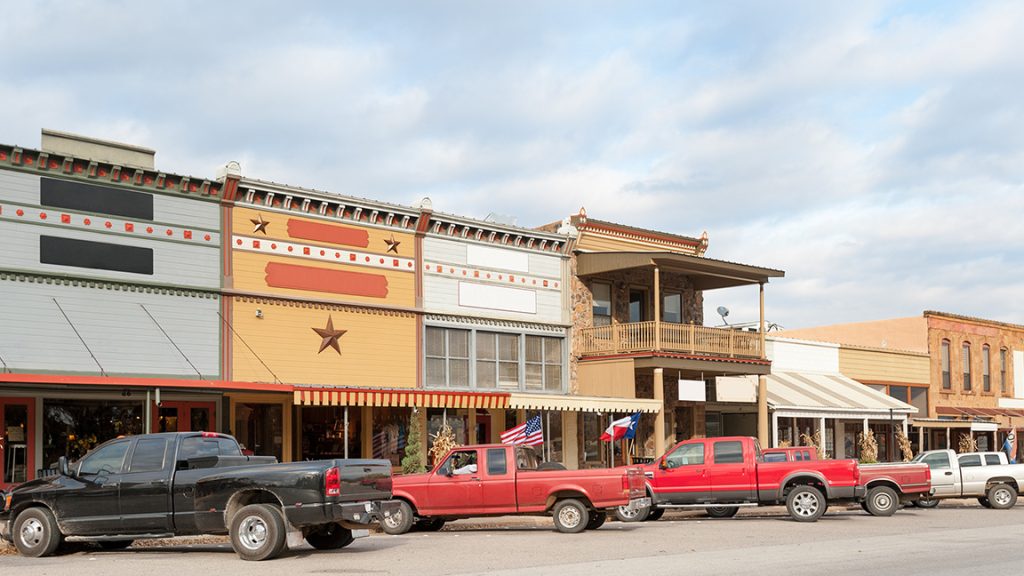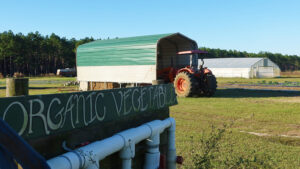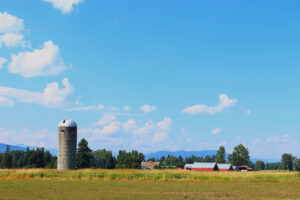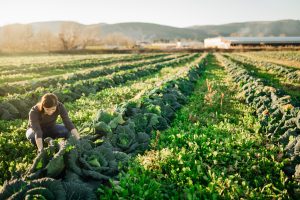Reposted from: https://www.thenation.com/article/politics/rural-voters-monopoly/
Wisconsin dairy farmer Sarah Lloyd believes she has the answer to a question that has convulsed the Democratic Party for the past four years. “People from the coasts are always like, ‘What’s going on with Wisconsin? How could they have possibly voted for Obama and then voted for Trump?’” she asks, putting on a falsetto to conjure the hysteria she often hears in such voices. On a chilly, overcast October afternoon, she lays out her theory at the 400-cow Columbia County farm she runs with her husband, which the couple recently considered shuttering after years of unsustainably low milk prices. A Democrat with a PhD in rural sociology, this third-generation farmer believes her party is sorely out of touch with an issue that resonates deeply in conservative heartland communities: countering the monopolistic level of corporate power that has emerged in agribusiness over the past 40 years.
“As the companies become bigger and more consolidated, it limits our ability to negotiate in the marketplace,” Lloyd explains, “which shows up in higher prices for our inputs”—seed, feed, fertilizer, tractor equipment, and so on. “It’s squeezing producers on all sides and making it difficult to stay afloat. We’re like little ants compared to these companies.” The GOP has not adequately addressed the issue either, she says, leaving an opening for Democrats. “Rural voters are like, ‘Give us something we can work with here.’”
President Barack Obama vowed to do exactly that during his 2008 campaign. He promised to enforce the Packers and Stockyards Act, 1920s-era antitrust legislation designed to put reins on meat companies that were racking up profits while farming families weathered oppressive levels of debt and the constant threat of bankruptcy. The law took aim at an early form of vertical integration in the livestock industry, in which companies were able to manipulate prices by controlling the production and the distribution of meat. A century later, the consolidation of the meatpacking industry in the hands of a few immensely profitable transnational corporations makes the 1920s seem quaint in comparison.
The law remains on the books, but over the years government oversight has grown exceedingly lax. After his election, Obama dispatched Secretary of Agriculture Tom Vilsack, the former governor of Iowa, to conduct a series of high-profile workshops on industry consolidation with farmers across the country. Lloyd recalls genuine excitement in rural corners that meaningful change was imminent. It turned out to be a “dog-and-pony show,” she says. “The Obama administration came out swinging and said they were going to get the DOJ to dig into the issue and try to create a level playing field. Nothing happened.”
While Democratic nominee Joe Biden’s platform discusses strengthening antitrust enforcement in agriculture, his approach to rural voters has consisted largely of pummeling Trump over his trade war with China and the economic pain it has inflicted on farmers. This summer, he told attendees of a virtual rally in Wisconsin, where dairy farms are shutting down at a rate of nearly two per day and farmer suicides are on the rise, that “Trump’s unmitigated tariff disaster” was to blame. While this has become a media mantra, the message may not resonate in rural communities the way the Democratic establishment seems to think.
Bill Bullard, the CEO of the Ranchers-Cattlemen Action Legal Fund, a conservative group working to stop anticompetitive practices in the meatpacking industry, says that’s because many farmers and ranchers favor protective tariffs. Free trade agreements have saturated the market with cheap imports, driving down the prices US farmers receive for their goods and promoting overproduction, he says.
“That is good for multinational agribusinesses”—it lowers costs, ensuring higher profits—“but it’s contrary to the economic interest of America’s farmers and ranchers and the rural communities they support,” says Bullard. “Free trade keeps prices below the cost of production. That’s why the average age of the American farmer is steadily increasing—young people can’t afford to get into the industry.”
Bullard’s group is a Second Amendment–touting, anti-abortion bunch, but on this issue they’re aligned with rural Democrats like Lloyd, who view free trade as a euphemism for consolidation. “The trade deals that have gone forward in both Republican and Democratic administrations are basically deals bought and paid for by corporations so they can move their capital around more easily,” Lloyd says. She points out that Bernie Sanders’s “going-after-the-big-guys” approach, as she puts it, helped him win every county in Wisconsin outside Milwaukee in the 2016 primary.
She draws an unflattering contrast with the Biden campaign’s approach. “The only person I’ve seen on the trail for Biden [in farm country] is Tom Vilsack.” She says the former ag secretary, now the CEO of the US Dairy Export Council, is squarely in the corporate corner, his million-dollar salary unpopular with struggling dairy farmers. “He’s not offering anything new,” says Lloyd. “He’s all about export markets and supporting consolidation, not anything that would actually support farmers and their families.”
Economists view industries with a “concentration ratio”—defined as the market share of the four largest companies—of 40 percent or more as anticompetitive, which covers most of agriculture. It’s happened at an astonishing speed. In 1986, the market share for the four largest poultry processors was 35 percent; by 2015, it was 58 percent. The market share of the biggest hog processors grew from 33 percent in 1976 to 70 percent 2015. The effect has been most pronounced in the beef industry, in which the concentration ratio ballooned from 25 percent in 1977 to 85 percent in 2015. The trajectories have been similar in the two biggest seed markets: Corn had an 85 percent concentration ratio by 2015; soybeans, 76 percent. Agrochemical concentration was 84 percent by 2017. Corporate consolidation in retail food distribution and equipment manufacturing has also risen to dangerous levels recently, with both at around 40 percent concentration.
Decades of mergers and vertical integration have left producers with little competitive leverage to shop around for chicken feed or choose which company they sell their hogs to. As a result, US farmers receive less than 15 cents of every dollar Americans spend on food, a number that has dropped about 20 percent since the USDA began publishing such statistics in the 1990s. People aren’t eating less—seed companies, agrochemical suppliers, food processors, and other corporations along the supply chain are taking a bigger chunk of the food dollar. And many of those firms are owned by foreign conglomerates, including the largest American pork company, Smithfield Foods (purchased by a Chinese group in 2013), JBS USA (a subsidiary of the world’s largest meatpacker, which is based in São Paulo, Brazil), and Monsanto (now owned by the Swiss chemical giant Bayer). It’s a picture that doesn’t quite jibe with President Trump’s made-in-America ethos.
Chris Gibbs, the Ohio soybean grower behind the billboards, hopes to help his fellow farmers make the leap. Earlier this year, Gibbs, a lifelong Republican who voted for Trump in 2016, founded Rural America 2020, an advocacy group aimed at “creating a safe space for rural America to speak out and go in a different direction,” he says. It would give license to people like Gibbs, who is now an independent and plans to vote for Biden. The group has targeted voters in six largely rural swing states—Iowa, Minnesota, Wisconsin, Michigan, Ohio and Pennsylvania—with radio ads, a social media campaign, billboards, banners pulled by airplanes above Trump rallies, and a website where Republican farmers who have changed teams can upload video testimonials about their conversion. “We’re a permission campaign,” says Gibbs, noting the intense social pressure to remain loyal to Trump in ag circles. “Creating a safe space means they can see that their friends, neighbors, and people from church are also changing their mind.”
Evidence of an agricultural exodus from the Republican Party is mixed at best. Gibbs’s group touts an August poll by DTN/Progressive Farmer, an agriculture news site (DTN stands for Data Transmission Network), that found an 18-point drop in farmers planning to vote for Trump between April and August this year. And he points to Fox News polling this summer that showed a pronounced contraction of Trump support among rural voters—after winning rural districts by 26 points in 2016, his lead over Biden was only nine points. However, a DTN/PF.com poll in late Septembershowed Trump’s lead among rural voters at 17 percent. And Farm Journal says the notion of shrinking support is hogwash: According to its polling, the percentage of farmers planning to vote for Trump has remained steady at 75 percent or above for the past year. The publication’s most recent poll, in August, showed Trump at 82 percent, while only 13 percent planned to vote for Biden.
Joe Maxwell, the president of Farm Action Fund, acknowledges that most farmers and rural voters will continue to back a GOP ticket because of social issues. But he believes that the least rigidly conservative among them could be picked off if the Democratic party seized on corporate power as a top concern—a slice that wouldn’t turn all rural districts blue by any stretch, but might prove decisive in key swing states.
Neither party has pursued the anti-corporate mantle because both are “in bed with big [ag],” says Maxwell. “They don’t want to talk about it,” despite there being “almost civil unrest among cattle producers,” he says.
In the broader reckoning over corporate power in America, the agriculture industry has received relatively little scrutiny from policy-makers—nothing like the spectacle playing out in Washington with the tech monopolies. The Trump administration has made gestures—the Department of Justice has pursued several agrobusinesses for anti-competitive practices—though Maxwell isn’t convinced that these are a harbinger of systemic change. “There are bolder actions they could make as evidence that they’re sincere and aren’t just trying to get headlines to calm the concerns out here in rural America,” he says. On the other side of the aisle, Senator Cory Booker of New Jersey has sponsored the Farm System Reform Act, which would make comprehensive reforms to realign the playing field in favor of farmers, rather than corporations (it has languished in Congress for the past year). And the Democratic primary saw a flurry of discussion about reining in ag monopolies, led by Senators Bernie Sanders and Elizabeth Warren. It faded, however, along with their campaigns. So as much as the issue resonates with farmers—a small, but electorally important constituency—it is scarcely on the November ballot.
A rare congressional candidate staking her name to the cause is Democrat Julie Oliver, a veteran of the health care industry who is running against incumbent Republican Representative Roger Williams, a former car dealership owner, in Texas’ 25th district, which covers the farm land between Austin and Dallas. Neither has a strong connection to agriculture, but by attempting to forge one on the campaign trail, Oliver is hoping to differentiate herself in the eyes of conservatives who wouldn’t ordinarily give a feminist from Austin (her campaign sells “Smash the Patriarchy” T-shirts) a second look, and garner a few extra votes to put her over the top. She’s neck-and-neck with Williams in the latest polling.
“We really need enforcement of the Packers and Stockyards Act because there is major price manipulation,” says Oliver, who organized a roundtable event on YouTube this summer with Jim Hightower, a former Texas agriculture commissioner and a titan of rural progressive politics. She points out that Wan Long, CEO of the Chinese conglomerate that owns Smithfield Foods, earns $291 million per year—roughly $800,000 per day. “He’s not hurting, but ranchers in Lampasas are.”
It’s the kind of talk that perks up a Texas cattle broker who doesn’t want his real name used because “I sell to a lot of these companies who are part of the problem.” A lifelong Republican who now considers himself a conservative-leaning independent, the broker plans to vote for Oliver because of her focus on enforcing antitrust rules. (Concerning her car-dealer opponent’s view on the Packers and Stockyards Act, he says, “I don’t think he knows much about it.”) The meatpackers have become so big that suppliers have lost most of their leverage. “There’s no negotiating anymore, because they don’t have to compete for the cattle,” he says.
This was especially stark with Covid-19, when meatpacking plants cut production due to workers falling ill. The retail price of beef went up 25 percent on the presumption of a meat shortage, but the increase in price was not passed on to ranchers, whose income per pound dropped 17 percent. “The typical profit margin for a packer is somewhere between $100 and $200 a head [of cattle],” says the broker. “This spring it skyrocketed to $1,000 a head, because of the difference between what they were selling the meat for and what they were buying it for.” Lawmakers on both sides of the aisle have since put forward bills to level the playing field in the cattle market, but none have moved forward.
Even Oliver’s smash-the-patriarchy rhetoric won’t dissuade this straitlaced Texan from voting for her. “White men have had more than 200 years to run this country, and in my opinion there’s a lot of things we’re doing wrong,” he says. “Maybe it’s time for a few women to run the damn thing.” Like ag policy reform, that cause will not be found at the top of the ticket in November. But the seeds are there, simmering, as the Democratic Party charts its future course.





